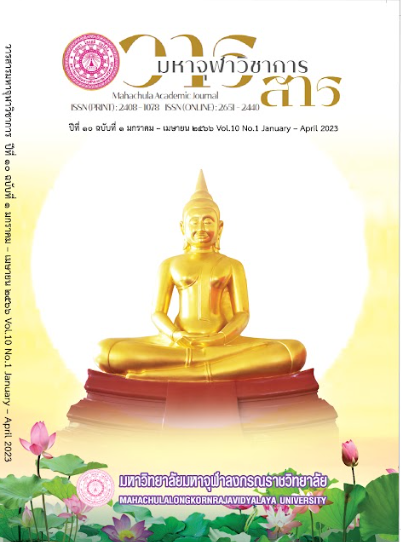An An Educational Management Model to Reinforce the Quality of Students for School Administrators Under the Secondary Educational Service Area Office Bangkok
Main Article Content
Abstract
The purposes of this research were as follows : (1) to study the components of an Educational Management to Reinforce the Quality of Students for School Administrators Under the Secondary Educational Service Area Office Bangkok, (2) to create an of the An Educational Management Model to Reinforce the Quality of Students for School Administrators Under the Secondary Educational Service Area Office Bangkok, and (3) to evaluate and affirm the of An Educational Management Model to Reinforce the Quality of Students for School Administrators Under the Secondary Educational Service Area Office Bangkok. The mixed methods research was used in the study. The research instruments were semi-structured interviews, questionnaires and confirmation or certification forms through 5-rating scale questionnaires by IOC; 0.6-1.0 discriminatory power equal to 0.33-0.89 with reliability at 0.986, informants consisting of school directors, vice-directors, and teachers in 92 schools. The analyzed by frequency, percentage, mean, standard deviation, and confirmatory factor analysis.
The results of this research was found that : (1) The components of an Educational Management to Reinforce the Quality of Students for School Administrators Under the Secondary Educational Service Area Office Bangkok, general education department consist of 15 components and 86 variables. (2) The an Educational Management Model to Reinforce the Quality of Students for School Administrators Under the Secondary Educational Service Area Office Bangkok, general education department from confirmatory factor analysis (CFA) indicated that the highest value was on (1) Student Quality Management Process (2) Promote the quality of learners (3) Quality Development of Learners and (4) Control the quality of learners. has a chi-square value = 2.466, DF = 4, P-value = .651, GFI = .999, AGFI = .973, and RMSER = .000. This result indicates that the model is consistent with the empirical data. (3) The evaluation and confirmation of the model from experts in its propriety, accuracy, feasibility, and utility is at 4.62 ( = 4.62), higher than the set criteria at = 3.51. That means the model is approved.
Article Details

This work is licensed under a Creative Commons Attribution-NonCommercial-NoDerivatives 4.0 International License.
References
กระทรวงศึกษาธิการ. แผนแม่บทเทคโนโลยีสารสนเทศและการสือสารเพื่อการศึกษาของกระทรวงศึกษาธิการ พ.ศ. ๒๕๕๔ – ๒๕๕๖. กรุงเทพมหานคร: สํานักปลัดกระทรวงศึกษาธิการ, ๒๕๕๔.
ปรียาพร วงค์อนุตรโรจน์. การบริหารงานวิชาการ. กรุงเทพมหานคร: พิมพ์ดี, ๒๕๕๓.
ธนสมพร มะโนรัตน์. “รูปแบบการพัฒนาคุณภาพผู้เรียนด้านผลสัมฤทธิ์ทางการเรียนระดับชาติของโรงเรียนบ้านห่องวารี (นิพัทธ์ธรรมาภรณ์อุปถัมภ์) สังกัดสำนักงานเขตพื้นที่การศึกษา ประถมศึกษาศรีสะเกษ เขต ๒”. รายงานการวิจัย. สำนักงานคณะกรรมการการศึกษาขั้นพื้นฐาน: กระทรวงศึกษาธิการ, ๒๕๖๐.
ไพฑูรย์ สินลารัตน์ และคณะ. การพัฒนารูปแบบการจัดการเรียนการสอนแบบ CRP. กรุงเทพมหานคร: จุฬาลงกรณ์มหาวิทยาลัย, ๒๕๕๐.
วรัยพร แสงนภาบวร.“สกศ.เสวนาวิชาการ”. วารสารการศึกษาไทย. ปีที่ ๗ ฉบับที่ ๖๗ (เมษายน ๒๕๕๓) : ๑๒-๑๔.
สมศรี เณรจาที. “รูปแบบการบริหารสถานศึกษาเพื่อพัฒนาคุณภาพของผู้เรียนให้มีคุณลักษณะพึง ประสงค์ในศตวรรษที่ ๒๑”. วิทยานิพนธ์ปรัชญาดุษฎีบัณฑิต. สาขาวิชาการบริหารเพื่อพัฒนาการศึกษา. บัณฑิตวิทยาลัย: มหาวิทยาลัยราชภัฎกาญจนบุรี, ๒๕๖๐.
สำนักงานคณะกรรมการการศึกษาขั้นพื้นฐาน. แนวทางการประเมินคุณภาพตามมาตรฐาน การศึกษาขั้นพื้นฐาน เพื่อการประเมินคุณภาพภายในสถานศึกษา. กรุงเทพมหานคร: โรงพิมพ์สำนักงานพระพุทธศาสนาแห่งชาติ, ๒๕๕๔.
สำนักงานเลขาธิการสภาการศึกษา. งานผลการวิจัยและพัฒนากรอบสมรรถนะผู้เรียนระดับประถมศึกษา ตอนต้นสำหรับหลักสูตรการศึกษาขั้นพื้นฐาน. กรุงเทพมหานคร: กระทรวงศึกษาธิการ, ๒๕๖๒.
สํานักงานเลขาธิการคุรุสภา. เกณฑ์มาตรฐานวิชาชีพครูของคุรุสภา พ.ศ. ๒๕๓๗. กรุงเทพมหานคร: คุรุสภา, ๒๕๔๙.
อรัญญา ชนะเพีย. “รูปแบบความสัมพันธ์เชิงสาเหตุของปัจจัยทางการบริหารที่ส่งผลต่อคุณภาพผู้เรียนในโรงเรียนสังกัดสำนักงานเขตพื้นที่การศึกษาประถมศึกษาในภาคตะวันออกเฉียงเหนือ”. วิทยานิพนธ์ปริญญาการศึกษาดุษฎีบัณฑิต. บัณฑิตวิทยาลัย: มหาวิทยาลัยมหาสารคาม, ๒๕๕๘.
Diggett, R., Preparing students their futurs. Rexford NY: International Center for Leadership in Education, 2005.
Teddlie, C & Renolde, D. International handbook of school effectiveness research An International servey of research on school effectiveness. London: Routledge, 2000.
Y. D. Silva, & F. N. Dana. Collaborative Supervision in the Professional Development School. Dissertation Abstracts International, Vol 16 no 21(2001) : p. 45-A.
Mckinsay. How the word most improved school system keep get better. Online].Available http//.mckinsey on society.com/how-the wored most improved school system keep getting better.[ 12 June 2012].

